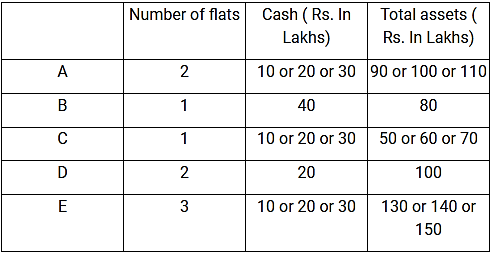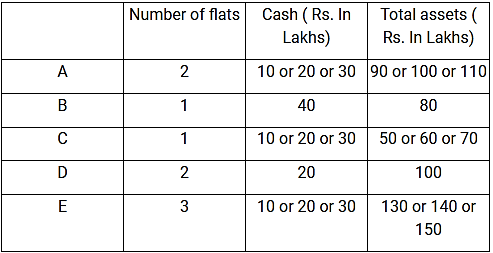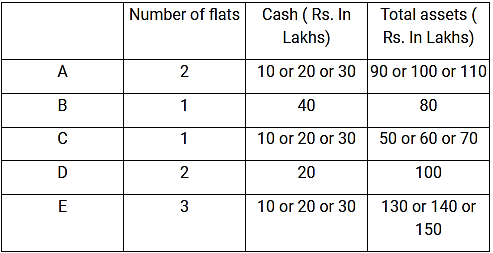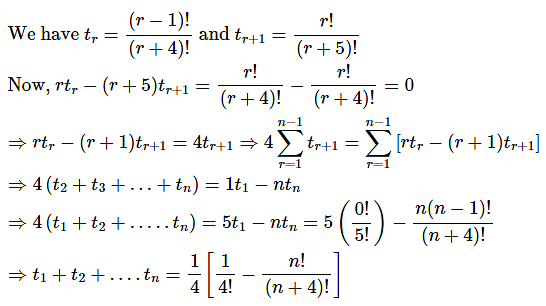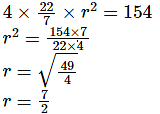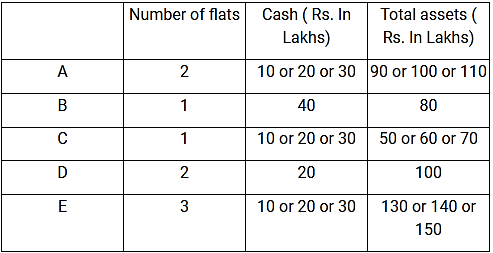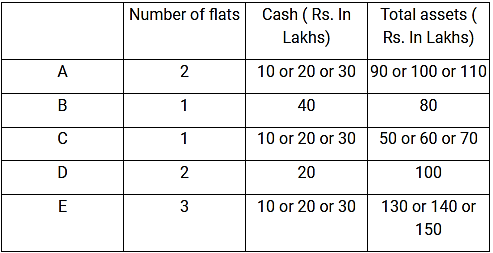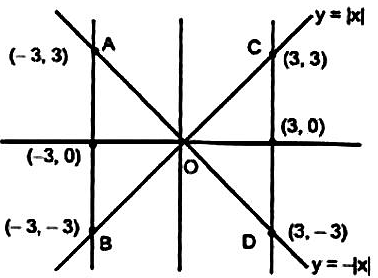IPMAT Mock Test - 8 (New Pattern) - Commerce MCQ
30 Questions MCQ Test IPMAT Mock Test Series - IPMAT Mock Test - 8 (New Pattern)
Answer the questions on the basis of the information given below:
A, B, C. D and E are five brothers. They have assets in the form of flats and cash only. Together they have 9 flats and each brother has at least 1 flat. Value (in terms of rupees) of all flats is equal and constant. Cash with each brother is an integral multiple of Rs. 10 lakhs. The amount of cash with B is just enough to buy one more flat, all the other brothers have cashless than that of B. E has got the maximum number of flats. A number of flats with A is equal to the sum of the number of flats with B and C. Amount of cash with B is double of that with D, but D has got assets worth Rs. 20 lakhs more than that of B.
What is the value of 1 flat?
Answer the questions on the basis of the information given below:
A, B, C. D and E are five brothers. They have assets in the form of flats and cash only. Together they have 9 flats and each brother has at least 1 flat. Value (in terms of rupees) of all flats is equal and constant. Cash with each brother is an integral multiple of Rs. 10 lakhs. The amount of cash with B is just enough to buy one more flat, all the other brothers have cashless than that of B. E has got the maximum number of flats. A number of flats with A is equal to the sum of the number of flats with B and C. Amount of cash with B is double of that with D, but D has got assets worth Rs. 20 lakhs more than that of B.
What is the ratio of the maximum possible value of assets of E to the minimum possible value of assets of C?
Answer the questions on the basis of the information given below:
A, B, C. D and E are five brothers. They have assets in the form of flats and cash only. Together they have 9 flats and each brother has at least 1 flat. Value (in terms of rupees) of all flats is equal and constant. Cash with each brother is an integral multiple of Rs. 10 lakhs. The amount of cash with B is just enough to buy one more flat, all the other brothers have cashless than that of B. E has got the maximum number of flats. A number of flats with A is equal to the sum of the number of flats with B and C. Amount of cash with B is double of that with D, but D has got assets worth Rs. 20 lakhs more than that of B.
For how many brothers is it possible to find out the exact value of their total assets?
All natural numbers that give remainders 1 and 2 when divided by 6 and 5, respectively, are written in ascending order, side by side from left to right. What is the 99th digit from the left?
A combo pack having a bulb and a tube light costs Rs. 52. If the cost of the bulb drops by 20% and the cost of the tube light escalates by 50%. the pack would cost Rs. 50. Find the price of a tube light?
How many sets of three distinct factors of the number N = 26 x 34 x 52 can be made such that the factors in each set have a highest common factor of 1 with respect to every other factor in that set?
Find all the values of p, such that 6 lies some where between the roots of the equation
x2 + 2(p - 3)x + 9 = 0. (‘x’ is a real number).
A manufacturing company conducted workshops on three techniques namely designing, formatting and testing for its executives. The number of executives who attended the workshop on designing is twice and thrice of the number of executives who attended the workshops on formatting and testing respectively. 42 executives attended the workshop on formatting. The aggregate number of executives who attended the workshops on exactly two techniques is at most 25% of the aggregate number of executives who attended the workshops on exactly one technique. Workshops on any combination of exactly two techniques were attended by more than 1 executive.
If the minimum possible executives attended the workshop on all three techniques, then find the minimum possible number of executives who attended the workshop on designing only.
How many integers “a” are there such that 9x2 + 3ax + (a + 5) > 0 for all values of x ?
a, b and c are positive real numbers such that a + b + c = p, where 'p' is a constant. Find the maximum value of (p - a) (p - b)(p - c).
What is the remainder when 36001 + 76000 is divided by 13?
In a shoe store, there are 12 highly expensive pair of shoes. One night, thieves break in and steal 4 shoes, not necessarily having a matching pair among them. What is the probability that at least one matching pair of shoes was stolen?
Read the following graph carefully and answer the question given below.
The bar chart given below shows the import of soya bean (in quintals) for the year 2011 to 2016.
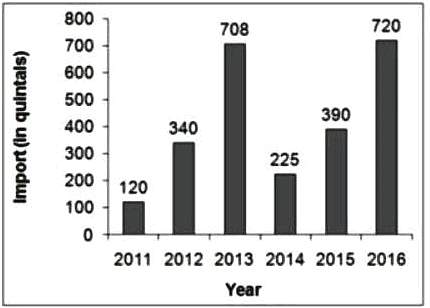
The import of Soya bean in the year 2015 is what per cent of the import of Soya bean in the year 2012?
Directions: Read the following graph carefully and answer the question given below.
The bar graph given below shows the per acre yield (in kg) of different countries. Study the graph carefully and answer the questions
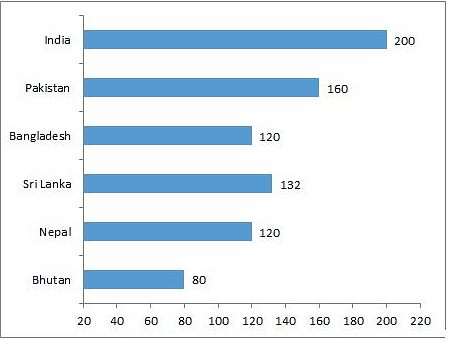
By how much percentage is India's per acre yield more than that of Bhutan's?
Find out the ratio of milk to that of water, if a mixture is formed after mixing milk and water of 3 same vessels containing the mixture of milk to that of water in the proportion 3:2, 7:3, 9:2 respectively.
A chemist has 20 litres of a solution that is 20% hydrochloric acid by volume. He wants to dilute the solution to 4% strength by adding water how many litres of water must be added?
The surface area of a sphere is 5024 m2. What is the volume of the sphere? (Approx)
What is the diameter (in cm) of a sphere of surface area 154 sq cm?
A boat running downstream covers a distance of 18 km in 2 hours while for covering the same distance upstream, it takes 3 hours. What is the speed of the boat in still water?
Answer the questions on the basis of the information given below:
A, B, C. D and E are five brothers. They have assets in the form of flats and cash only. Together they have 9 flats and each brother has at least 1 flat. Value (in terms of rupees) of all flats is equal and constant. Cash with each brother is an integral multiple of Rs. 10 lakhs. The amount of cash with B is just enough to buy one more flat, all the other brothers have cashless than that of B. E has got the maximum number of flats. A number of flats with A is equal to the sum of the number of flats with B and C. Amount of cash with B is double of that with D, but D has got assets worth Rs. 20 lakhs more than that of B.
What can be the maximum possible value of assets of A?
Answer the questions on the basis of the information given below:
A, B, C. D and E are five brothers. They have assets in the form of flats and cash only. Together they have 9 flats and each brother has at least 1 flat. Value (in terms of rupees) of all flats is equal and constant. Cash with each brother is an integral multiple of Rs. 10 lakhs. The amount of cash with B is just enough to buy one more flat, all the other brothers have cashless than that of B. E has got the maximum number of flats. A number of flats with A is equal to the sum of the number of flats with B and C. Amount of cash with B is double of that with D, but D has got assets worth Rs. 20 lakhs more than that of B.
What can be the maximum possible value of the assets of all the brothers taken together?
Bag A contains 6 white balls and 4 black balls and bag B contains 3 white balls and 2 black balls. A white ball is picked from bag A and put into bag B. Then, three balls are picked from bag B and put into bag A. Find the probability that a ball picked now from bag A is black.
Find the area of bounded regions generated by the curves |x| = 3, y = |x| and y = -|x|.
Three numbers first are twice the second and second is twice the third. The average of the three numbers is 21. Find the largest number of the three.
Pawan was designing a Mock test. He had 8 questions for this Mock test and he had to assign a total of 30 marks to the 8 questions in this Mock test. If the minimum marks assigned to a question is 2 and each question carries integral marks, then how many ways are possible for Pawan to distribute 30 marks in this Mock test?
Let M be a three-digit number denoted by ‘ABC’ where A. B and C are numerals from 0 to 9. Let N be a number formed by reversing the digits of M. It is known that M - N + 396C is equal to 990. How many possible values of M are there which are greater than 300?
A manufacturing company conducted workshops on three techniques namely designing, formatting and testing for its executives. The number of executives who attended the workshop on designing is twice and thrice of the number of executives who attended the workshops on formatting and testing respectively. 42 executives attended the workshop on formatting. The aggregate number of executives who attended the workshops on exactly two techniques is at most 25% of the aggregate number of executives who attended the workshops on exactly one technique. Workshops on any combination of exactly two techniques were attended by more than 1 executive.
If the maximum possible executives attended the workshop on all three techniques, then find the maximum possible number of executives who attended the workshop on both designing and formatting but not testing.
25x2 + y2 = 34 and xy = 3, then value of (125x3 + y3) is:
A natural number is randomly selected from 100 to 360. Find the probability that it is divisible by exactly two of the three numbers 4, 6 and 8.
|
4 docs|10 tests
|


